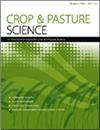Characterisation of buckwheat (Fagopyrum spp.) diversity of the northwestern Himalayas
IF 1.9
4区 农林科学
Q2 AGRICULTURE, MULTIDISCIPLINARY
引用次数: 2
Abstract
ABSTRACT Content. Knowledge about genetic variability parameters is imperative for improving crop plants for traits of economic importance. This paper reports the characterisation of a large germplasm set of an underutilised pseudocereal Buckwheat endemic to northwestern Himalayas in order to elucidate the nature of variability as well as identify trait specific genotypes for use in buckwheat breeding programmes. Aim. The major aim was to estimate the genetic variability of yield and related traits in diverse germplasm lines of buckwheat collected from different regions of the north-western Himalayas. Methods. The material was evaluated in a randomised complete block design with five replications at two different locations in SKUAST-K, Shuhama and MAR & ES Izmarg, Gurez, during the years 2020 and 2021. For assessing diversity patterns, the clustering of the germplasm from both locations was done by Tocher’s method. Key results. The results indicated significant variability in the buckwheat germplasm for all morphological traits across locations. The phenotypic cofficient of variation and genotypic coefficients of variation (PCV, GCV), broad sense heritability and genetic advance values varied between locations. Pooled across locations, the highest PCV values were recorded for number of primary branches. Heritability ranged from low for number of secondary branches to medium for days to 50% flowering. Conclusion. The present study provided valuable insights about the variability and trait diversity in buckwheat germplasm under Northwestern Himalayan conditions. Implications. The information on variability parameters can be harnessed to develop an effective breeding strategy for improving buckwheat for traits of economic interest.喜马拉雅西北地区荞麦(Fagopyrum spp.)多样性特征
抽象的内容。关于遗传变异参数的知识对于改善作物的经济性状是必要的。本文报道了喜马拉雅西北地区特有的一种未被充分利用的假谷物荞麦的一大种质资源集的特征,以阐明变异性的本质,并确定性状特异性基因型,用于荞麦育种计划。的目标。主要目的是估计喜玛拉雅山西北不同地区荞麦不同种质系产量及相关性状的遗传变异。方法。该材料在2020年和2021年期间在SKUAST-K, Shuhama和MAR & ES Izmarg, Gurez的两个不同地点进行了5个重复的随机完全块设计。为了评估多样性模式,采用Tocher方法对两个地点的种质资源进行聚类。关键的结果。结果表明,荞麦种质的所有形态性状在不同地点存在显著差异。表型变异系数和基因型变异系数(PCV、GCV)、广义遗传力和遗传超前值在不同地区存在差异。汇集在各个地点,最高的PCV值记录了主分支的数量。遗传率从低次枝数到中等日数到50%开花。结论。本研究为了解西北喜马拉雅条件下荞麦种质资源的变异性和性状多样性提供了有价值的见解。的影响。变异参数的信息可以用来制定有效的育种策略,以改善荞麦的经济利益性状。
本文章由计算机程序翻译,如有差异,请以英文原文为准。
求助全文
约1分钟内获得全文
求助全文
来源期刊

Crop & Pasture Science
AGRICULTURE, MULTIDISCIPLINARY-
CiteScore
4.20
自引率
15.80%
发文量
111
审稿时长
3 months
期刊介绍:
Crop and Pasture Science (formerly known as Australian Journal of Agricultural Research) is an international journal publishing outcomes of strategic research in crop and pasture sciences and the sustainability of farming systems. The primary focus is broad-scale cereals, grain legumes, oilseeds and pastures. Articles are encouraged that advance understanding in plant-based agricultural systems through the use of well-defined and original aims designed to test a hypothesis, innovative and rigorous experimental design, and strong interpretation. The journal embraces experimental approaches from molecular level to whole systems, and the research must present novel findings and progress the science of agriculture.
Crop and Pasture Science is read by agricultural scientists and plant biologists, industry, administrators, policy-makers, and others with an interest in the challenges and opportunities facing world agricultural production.
Crop and Pasture Science is published with the endorsement of the Commonwealth Scientific and Industrial Research Organisation (CSIRO) and the Australian Academy of Science.
 求助内容:
求助内容: 应助结果提醒方式:
应助结果提醒方式:


